Attached files
| file | filename |
|---|---|
| 8-K - FORM 8-K - REGIONS FINANCIAL CORP | d8k.htm |
 2011 Citi Financial Services Conference
March 9, 2011
David Turner,
Chief Financial Officer
Exhibit 99.1 |
 Forward-Looking Statements
2
This presentation may include forward-looking statements which reflect Regions’ current views
with respect to future events and financial performance. The Private Securities Litigation Reform Act of 1995 (“the Act”) provides
a “safe harbor” for forward-looking statements which are identified as such and are
accompanied by the identification of important factors that could cause actual results to differ materially from the forward-looking statements.
For these statements, we, together with our subsidiaries, claim the protection afforded by the safe
harbor in the Act. Forward-looking statements are not based on historical information, but rather are related to future
operations, strategies, financial results or other developments. Forward-looking statements
are based on management’s expectations as well as certain assumptions and estimates made by, and information available to,
management at the time the statements are made. Those statements are based on general assumptions
and are subject to various risks, uncertainties and other factors that may cause actual results to differ materially from
the views, beliefs and projections expressed in such statements. These risks, uncertainties and
other factors include, but are not limited to, those described below:
›
The Dodd-Frank Wall Street Reform and Consumer Protection Act became law on July 21, 2010, and a
number of legislative, regulatory and tax proposals remain pending. Additionally, the U.S. Treasury and
federal banking regulators continue to implement, but are also beginning to wind down, a number of
programs to address capital and liquidity in the banking system. Proposed rules, including those that are part
of the Basel III process, could require banking institutions to increase levels of capital. All
of the foregoing may have significant effects on Regions and the financial services industry, the exact nature of which
cannot be determined at this time.
›
The impact of compensation and other restrictions imposed under the Troubled Asset Relief Program
(“TARP”) until Regions repays the outstanding preferred stock and warrant issued under the TARP,
including restrictions on Regions’ ability to attract and retain talented executives and
associates. ›
Possible additional loan losses, impairment of goodwill and other intangibles, and adjustment of
valuation allowances on deferred tax assets and the impact on earnings and capital.
›
Possible changes in interest rates may increase funding costs and reduce earning asset yields, thus
reducing margins. Increases in benchmark interest rates would also increase debt service requirements for
customers whose terms include a variable interest rate, which may negatively impact the ability of
borrowers to pay as contractually obligated. › Possible changes in general economic and business conditions in
the United States in general and in the communities Regions serves in particular, including any prolonging or worsening of the current
unfavorable economic conditions, including unemployment levels.
›
Possible changes in the creditworthiness of customers and the possible impairment of the collectability
of loans. ›
Possible changes in trade, monetary and fiscal policies, laws and regulations and other activities of
governments, agencies, and similar organizations, may have an adverse effect on business.
›
The current stresses in the financial and real estate markets, including possible continued
deterioration in property values. › Regions' ability to manage fluctuations in the value
of assets and liabilities and off-balance sheet exposure so as to maintain sufficient capital and liquidity to support Regions' business.
›
Regions' ability to expand into new markets and to maintain profit margins in the face of competitive
pressures. ›
Regions' ability to develop competitive new products and services in a timely manner and the acceptance
of such products and services by Regions' customers and potential customers.
›
Regions' ability to keep pace with technological changes.
›
Regions' ability to effectively manage credit risk, interest rate risk, market risk, operational risk,
legal risk, liquidity risk, and regulatory and compliance risk.
›
Regions’ ability to ensure adequate capitalization which is impacted by inherent uncertainties in
forecasting credit losses. ›
The cost and other effects of material contingencies, including litigation contingencies,
and any adverse judicial, administrative or arbitral rulings or proceedings.
›
The effects of increased competition from both banks and non-banks.
›
The effects of geopolitical instability and risks such as terrorist attacks.
›
Possible changes in consumer and business spending and saving habits could affect Regions' ability to
increase assets and to attract deposits. › The effects of weather and natural disasters such as floods,
droughts and hurricanes, and the effects of man-made disasters such as the Gulf of Mexico oil spill.
›
Possible downgrades in ratings issued by rating agencies.
›
Potential dilution of holders of shares of Regions’ common stock resulting from the U.S.
Treasury’s investment in TARP. › Possible changes in the speed of loan prepayments by
Regions’ customers and loan origination or sales volumes.
›
Possible acceleration of prepayments on mortgage-backed securities due to low interest rates and
the related acceleration of premium amortization on those securities.
›
The effects of problems encountered by larger or similar financial institutions that adversely affect
Regions or the banking industry generally. › Regions’ ability to receive dividends from its
subsidiaries. ›
The effects of the failure of any component of Regions’ business infrastructure
which is provided by a third party. › Changes in accounting policies or procedures as may be required
by the Financial Accounting Standards Board or other regulatory agencies.
›
The effects of any damage to Regions’ reputation resulting from developments related to any of the
items identified above. The foregoing list of factors is not exhaustive. For discussion of these
and other factors that may cause actual results to differ from expectations, look under the captions “Forward-Looking Statements” and “Risk Factors” in
Regions’ Annual Report on Form 10-K for the year ended December 31, 2010.
The words "believe," "expect," "anticipate," "project," and similar
expressions often signify forward-looking statements. You should not place undue reliance on any forward-looking statements, which speak only as of the
date made. We assume no obligation to update or revise any forward-looking statements that are made
from time to time. |
 Our
primary focus is returning to sustainable profitability through
disciplined execution of our
strategic priorities
3 |
 Why
Regions? •
Strong Southeastern franchise with comprehensive line
of business offerings
•
Leading brand favorability and exceptional service
quality
•
Solid core business performance
•
Aggressively identifying and disposing of problem assets
•
Capital and liquidity remain solid
4 |
 Ranked 5
or Better in Market Share
Targeted Growth Areas
Headquarters
Birmingham, AL Associates
27,829
Branches
1,772
Morgan Keegan Offices
321
Regions Insurance
Offices 30
ATMs
2,148
Deposits*
$95 Billion
Loans*
$83 Billion
Projected population growth for
Regions footprint is above US average
growth
Operate on one fully integrated
technology platform
# 1 Market Share in Alabama,
Tennessee and Mississippi
Strong Southeastern Franchise
5
* As of 12/31/2010
th |
 Consumer Services
6
Deposits
Mortgage
Consumer
Lending
Insurance
Credit/Debit
Cards
Branches
Online
Banking
Mobile
Banking
Telebanking
ATMs
Diversified Offerings
Multi-Channel Delivery
Private
Banking |
 Business Services
7
Business Segments
Small Business
Middle Market
Real Estate
Core Middle Market
Sales > $20MM
Specialized Groups
Public, Institutional, Not for
Profit, Healthcare, Transportation,
Franchise Restaurant, Energy,
Regions Business Capital
Commercial Real Estate
Affordable Housing
Homebuilders
Real Estate Corporate
Banking
Product Groups
Treasury Management
Capital Markets /
Syndications
Equipment Finance
Relationship Managed
›
Business Banking (Metro
Markets)
›
Sales $2-20MM
Community Banking
Sales > $2MM
Branches
Sales < $2MM |
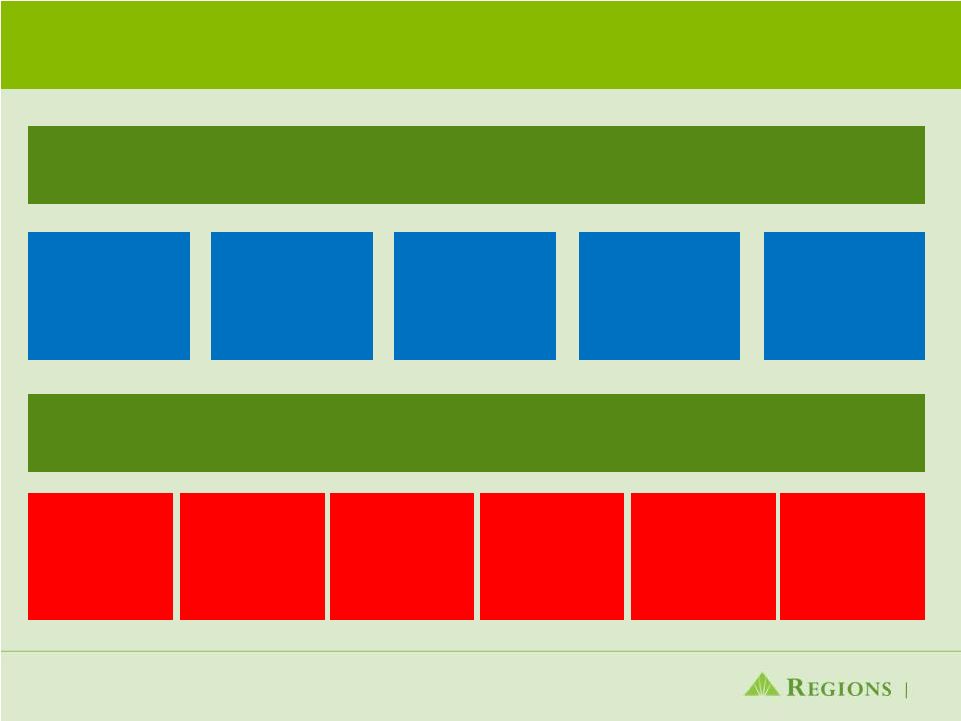 Morgan
Keegan 8
Business Units
Fixed Income
Capital Markets
Equity Capital
Markets
Investment
Banking
Private Client
Group
Regions
Morgan
Keegan Trust
Services
Institutional
Sales &
Trading,
Fixed Income
Research
Equity
Research,
Institutional
Sales &
Trading
Municipal
Finance, M&A
Public
Offerings,
Corporate
Debt
Retail
Brokerage
Personal &
Institutional
Trust, Timber
Management |
 Competitive
Advantage
Driven
by
Customer Loyalty
Regions continues to perform in
the top 10% in customer
loyalty and top 20% for
branch service quality
(2)
(1)
Based on TNS survey 3Q10 Consumer Banking Market Effectiveness Study
(2)
Based on Gallup survey
(3)
Based on Bain survey
(4)
Based on Prime Performance study
(5)
2010 Greenwich Excellence Award
Regions has the highest
brand favorability
(1)
Regions named “Friendliest
Bank”
(4)
Regions received Excellence
Award for Small Business and
Middle
Market
Banking
(5)
Regions ranked top in
customer
loyalty
(3)
Outstanding
customer growth and
retention
Approximately 1
million new checking
accounts in 2009 and
2010
Continue to be
recognized for our
Excellent Service
Quality and Brand
Strength
Effectively meeting
customers’
needs
allows Regions to
gain market share
What Makes Us Different?
9 |
 Strong Low-Cost Deposit Growth
While Driving Lower Deposit Costs
10
(1)
Full Year Average
Low Cost Deposits
(1)
Deposit Costs
(1) |
 Improved Deposit Mix
•
Reduced Average Time Deposit mix from 35% in 2009 to 27% in 2010
•
Grew Low-Cost Deposits 14% year-over-year
11
Average Deposits $94.6B
Average Deposits $96.5B |
 Disciplined Focus on New Checking Account Growth
•
Approximately 1 million new checking accounts in 2009 and 2010
•
Grew
quality
checking
accounts
(1)
by
3%
over
2009
•
Increased sales productivity with new account sales per branch improving
3.4% from 2009
•
Continued efforts to improve checking portfolio profitability through fee
generating accounts that provide customer value and fairly compensate
Regions
•
Fee based accounts grew 262% over 2009
•
Realize full potential of new accounts by selling deeper to new relationships
through new account conversations and onboarding
12
(1)
Quality
checking
accounts
are
those
accounts
that
have
a
average
balance
of
$500
and
/
or
have
at
least 10
customer transactions |
 Consumer Loan Production Improving;
However Consumers Continue to De-Leverage
13
Mortgage Production remains strong –
second best year in terms of Mortgage
Production
New Consumer Loan Production
volumes are improving in Branch Small
Business, Direct and Indirect Auto
$38.2
($11.4)
$8.1
$34.8
$1.8B
$2.4B
$3.0B
$3.4B
Consumers De-Leveraging continues
to outpace Loan Production
Consumer Confidence and
Unemployment need to improve before
robust loan growth is achieved
*$5.2B in Mortgage production sold to Agencies
Consumer Loan Production
Consumer Loans |
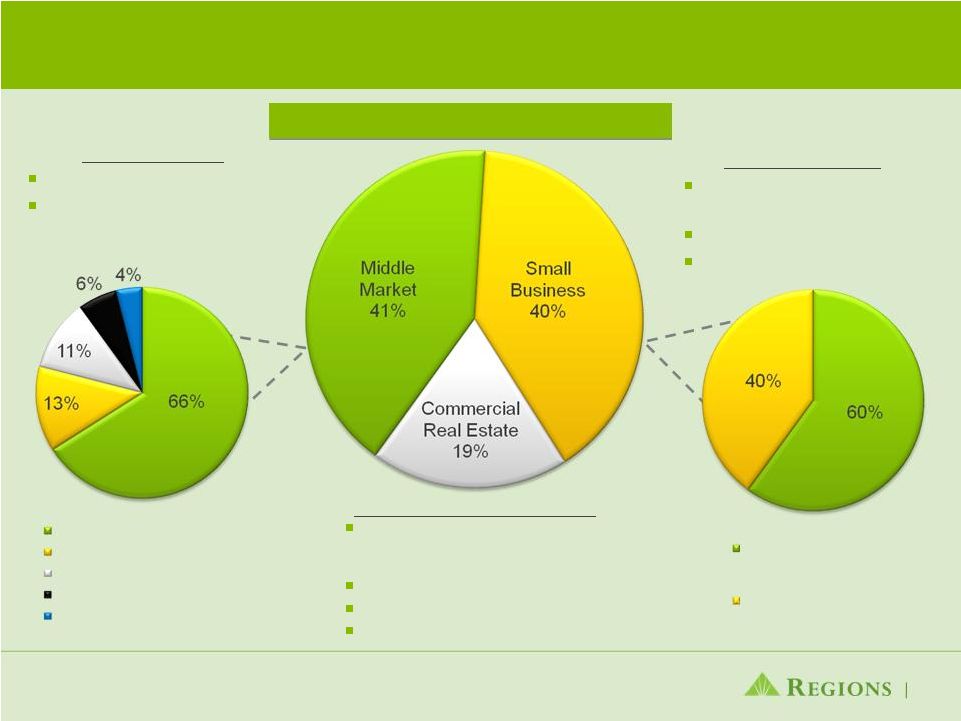 Small Business
Business Banking (Metro
Markets)
Community Banking
Branch Small Business
Middle Market
Commercial and Industrial
Specialized Groups
Commercial Real Estate
Professional income property
developers, owners and
operators
Public real estate companies
Homebuilders
Affordable housing tax credits
Middle Market and Small Business Comprise
81% of Business Service Revenue
14
Total Business Services Revenue
Core Middle Market
Public, Institutional, Not For Profit
Specialized Industries
Regions Business Capital
Regions Equipment Finance
Business & Community
Relationship
Managed
Branch Small Business |
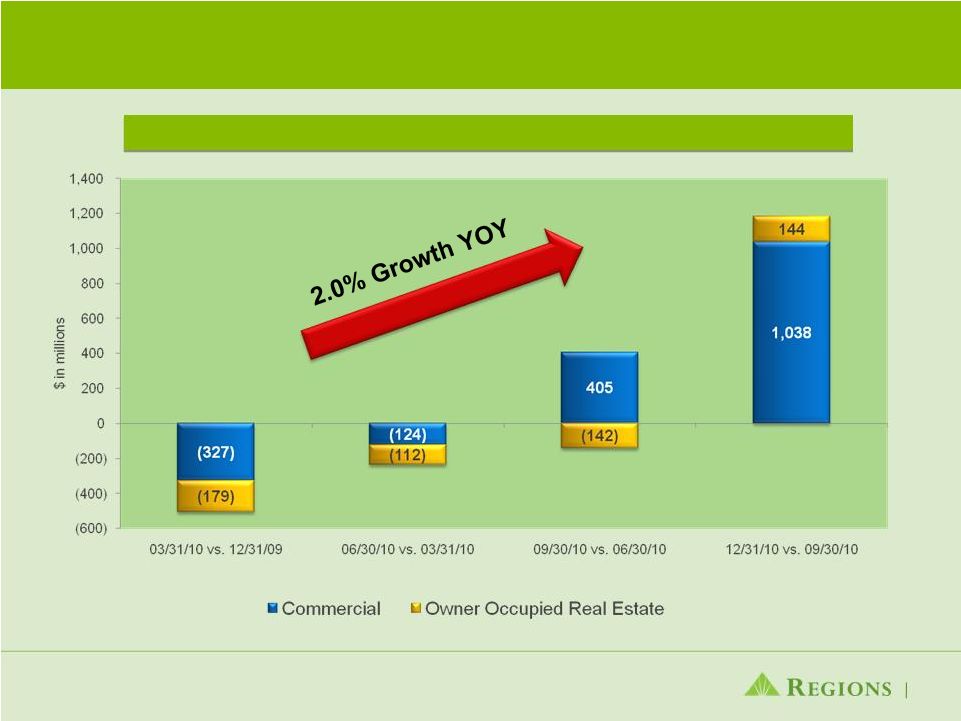 We
are Growing Commercial Loans 15
Commercial & Owner Occupied Real Estate Loan Growth
|
 Core
revenue continues to grow 16
* Non-GAAP; refer to Appendix for Non-GAAP reconciliation
($ in millions)
Net Interest
Income
Core Non-
Interest
Revenue*
Total
Core
Revenue
4Q10
$877
+
$794
=
$1,671
3Q10
$868
+
$748
=
$1,616
2Q10
$856
+
$756
=
$1,612
1Q10
$831
+
$734
=
$1,565
4Q09
$850
+
$743
=
$1,593 |
 Net
Interest Margin Impacted by Excess Liquidity and Non-Accruals
17
Net Income & Net Interest Margin
Impact of Excess Liquidity &
Non-Accruals on NIM
3.00%
3.27%
3.20%
3.19%
3.06% |
 Growth of Fee Income and Debit Card Interchange
$85M
$92.6M
$93.6M
$96.8M
Migration to Fee Based Accounts
Growth in Debit / ATM Fees
18 |
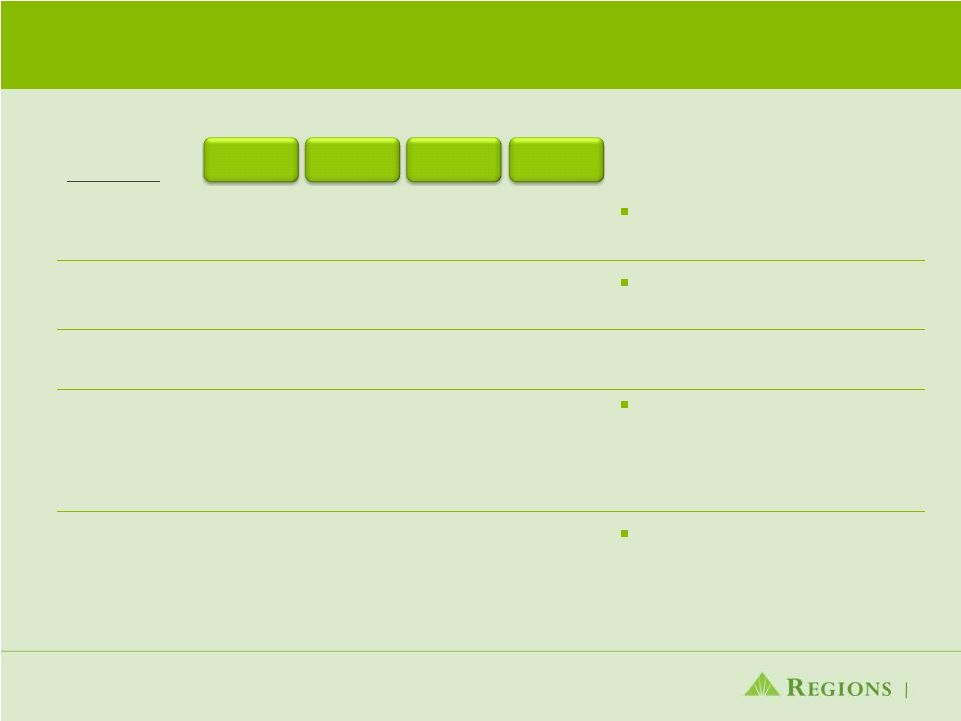 ($
in millions) 2007
2008
2009
2010
Branches
1,965
1,900
1,895
1,772
Reduced branch count by 10%
since 2007
Headcount
33,161
30,784
28,509
27,829
Headcount declined 5,332 or
16%
Total
Expenses
$4,660
$4,792
(1)
$4,751
$4,985
Adjusted
Expenses
(2)
$4,246
$4,448
$4,559
$4,667
Expenses continue to be
impacted by credit-related
expenses, elevated FDIC
expenses and professional and
legal fees
Credit-related
expenses
$153
$282
$424
$439
Credit-related costs should
subside as the economy
recovers
Strengthened Our Core Franchise
Through Productivity & Efficiency Initiatives
(1)
Excludes $6 billion goodwill impairment
(2)
Non-GAAP; refer to Appendix for Non-GAAP reconciliation
19 |
 Non-Performing Loan Inflows Decline
Ending Balances
NPL Inflow by Type
Business Services Gross NPLs
20 |
 Non-performing Asset Levels Decline
›
Non-performing assets declined $308 million from third quarter
›
For the full year declined $494 million
Non-Performing Assets
21 |
 Conservative Marks and Reserves Already Taken
on Impaired Loans
Impaired Loans as of December 31, 2010
($ in millions)
Legal
Balance
Charge-offs
& Payments
Received
Book Value
Related
Allowance
Charge-offs,
Payments and
Allowance as %
of Legal Balance
Commercial and industrial
$
545
$
124
$
421
$
102
41%
Commercial real estate mortgage -
owner occupied
746
96
650
167
35%
Commercial
real
estate
construction
-
owner
occupied
47
16
31
10
55%
Total commercial
1,338
236
1,102
279
38%
Commercial investor real estate mortgage
1,693
273
1,420
319
35%
Commercial investor real estate construction
638
150
488
154
48%
Total investor real estate
2,331
423
1,908
473
38%
Residential first mortgage
1,113
60
1,053
126
17%
Home equity
378
13
365
46
16%
Indirect and other consumer
67
-
67
1
1%
Total consumer
1,558
73
1,485
173
16%
Total impaired loans
$
5,227
$
732
$
4,495
$
925
32%
22
Note1: Impaired loans include non-accrual commercial and investor real estate loans, excluding
leasing, and all TDRs (including accruing commercial, investor real estate, and consumer TDRs)
Note 2: Book Value represents the total unpaid principal balance of the impaired loans, which is
reduced for interest payments received on non-accrual loans. Book Value is shown before
any allowance for loan losses. Note 3: Legal balance represents the contractual obligation due from the customer and includes net
book value plus cumulative partial charge-offs and interest payments received on
principal. |
 Loan
Charge-Offs and Allowance HFS
(1)
(1) Loan charge-offs related Sales / Transfer to Held for Sale
(2) Excludes loans held for sale
Loan Charge-Offs
Allowance & Coverage
23 |
 Higher
Risk Portfolio Segments Significantly Reduced
24
Reduced Investor Real Estate $9.9 B
or
38%
over 4 years
Total Investor Real Estate
Higher Risk Investor Real Estate
Segments
Reduced High Risk Segments $10.4 B
or
76%
over 4 years |
 Solid
Capital; Above proposed Basel minimum ratios
Basel Tier 1
Basel T1C
25 |
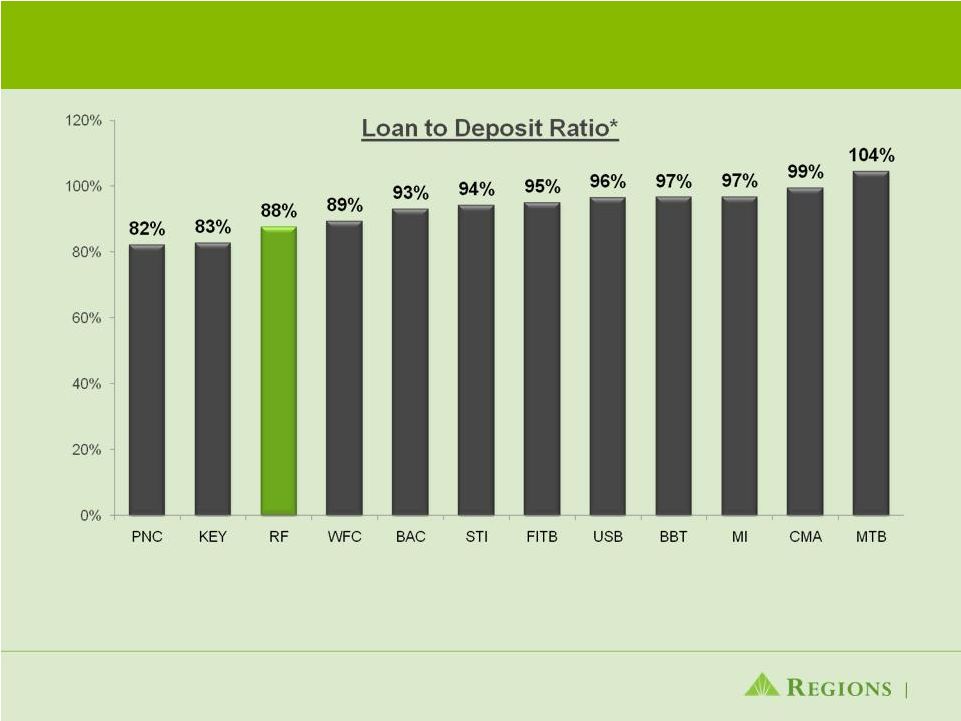 Favorable liquidity position
26
›
Regions low loan to deposit ratio favorable among peers
›
Favorable funding mix driven by low cost deposits
* Based on 4Q10 ending balances |
 Why
Regions? •
Strong Southeastern franchise with comprehensive line
of business offerings
•
Leading brand favorability and exceptional service quality
•
Solid core business performance
•
Aggressively identifying and disposing of problem assets
•
Capital and liquidity remain solid
27 |
 |
 Non-GAAP reconciliation -
Revenue
Note: The following table illustrates the method of calculating the Non-GAAP
financial measures used in this slide presentation:
29
($ amounts in millions)
4Q09
1Q10
2Q10
3Q10
4Q10
Net Interest Income (GAAP)
850
$
831
$
856
$
868
$
877
$
Non-Interest Revenue (GAAP)
718
812
756
750
1,213
Total Revenue (GAAP)
1,568
1,643
1,612
1,618
2,090
Adjustments:
Securities (gains) losses, net
96
(59)
-
(2)
(333)
Gain on sale of mortgage loans
-
-
-
-
(26)
Leveraged lease termination gains
(71)
(19)
-
-
(59)
Total adjustments
25
(78)
-
(2)
(418)
Adjusted Total Revenue (non-GAAP)
1,593
$
1,565
$
1,612
$
1,616
$
1,672
$ |
 Non-GAAP reconciliation -
Expenses
Note: The following table illustrates the method of calculating the Non-GAAP
financial measures used in this slide presentation:
30
($ in millions)
2007
2008
2009
2010
Total Non-Interest Expenses (GAAP)
$ 4,660
$ 10,792
$ 4,751
$ 4,985
Adjustments:
Goodwill impairment charge
6,000
Regulatory settlement charge
200
Merger-related charges
351
201
FDIC Special Assessment
64
Other-than-temporary impairment expense
6
22
75
2
MSR impairment
6
85
Loss on early extinguishment of debt
65
108
Branch consolidation charges
53
8
VISA settlement
51
(29)
-
-
Adjusted Non-Interest Expenses (non-GAAP)
4,246
$
4,448
$
4,559
$
$ 4,667 |
